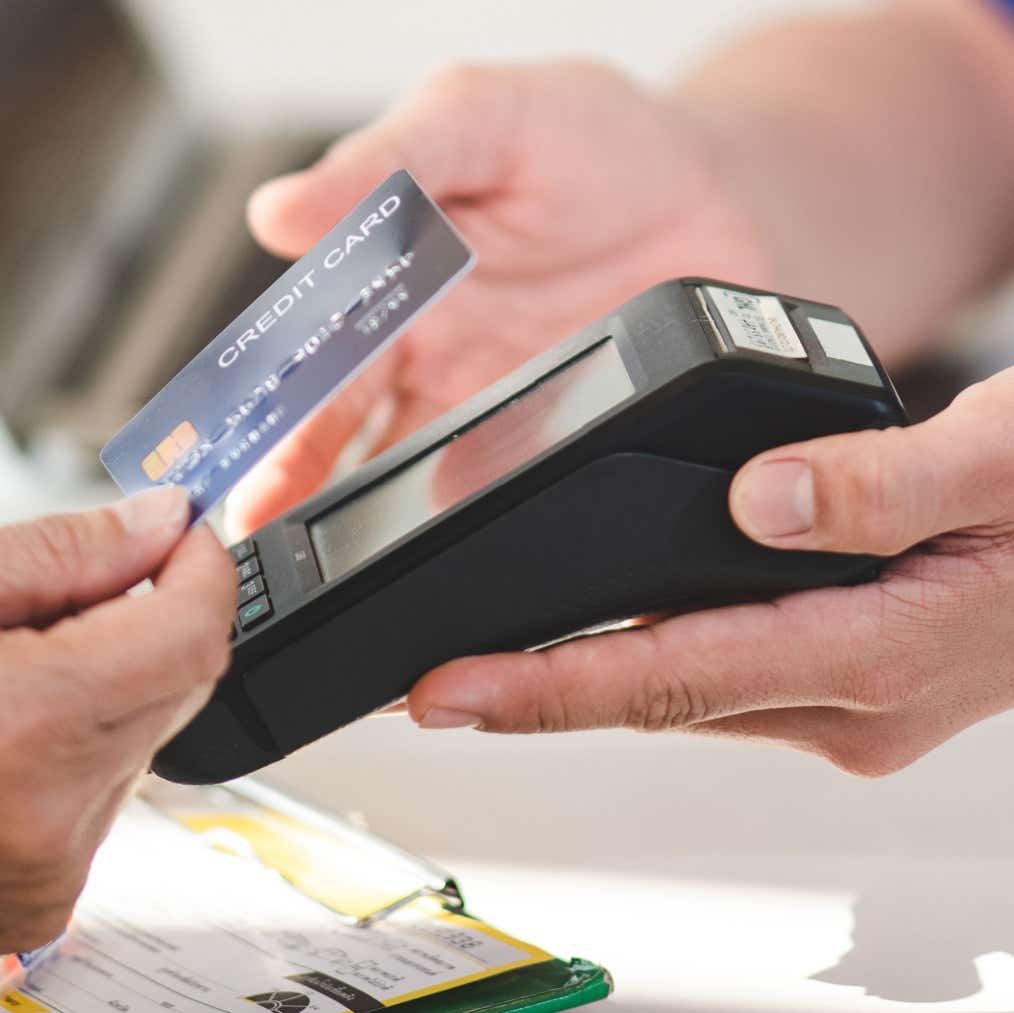- Uswitch.com>
- Business>
- Interchange fees: what are they, how do they work and how can you reduce costs?
Interchange fees explained
Here’s what you need to know about interchange fees and how to keep costs down.

If your business accepts card payments, every time a customer uses a debit or credit card to pay for the goods or services you sell, you pay an interchange fee.
Although you never pay interchange fees directly, your payment provider incorporates them into the transaction fees it charges. Over time, these costs add up and eat into your profit margin, and if you process a high volume of small payments or rely heavily on credit card sales, the impact can be significant.
This guide takes a closer look at how interchange fees work and what you can do to keep costs to a minimum to protect your business.
At a glance
An interchange fee applies whenever a customer pays for services or goods by credit or debit card
The fee helps the customer’s bank cover the cost of processing the transaction, as well as other expenses, such as fraud prevention measures
Interchange fees in the UK are currently capped, but credit card fees are typically higher than debit card fees
You can’t negotiate your interchange fees, but you can discuss the overall merchant service charge
You can further reduce costs by setting minimum transaction limits and considering alternative payment methods
Find the best card machine for your business

What are interchange fees?
Interchange fees are transaction fees charged between banks whenever a customer makes a card payment. They work as follows:
When a customer pays by debit or credit card, the merchant’s bank, known as the acquiring bank, pays a small fee to the customer’s bank (issuing bank)
This is the interchange fee, and it compensates the issuing bank for the cost of processing the card transaction, along with other expenses, such as fraud prevention measures
Interchange fees make up the largest chunk of card processing fees and therefore affect how much it costs your business to accept card payments.
How much are interchange fees?
Card networks such as Visa, Mastercard and American Express set interchange fees, which means they can vary. However, the UK Interchange Fee Regulation (IFR) caps interchange fees on consumer debit and credit charge transactions (excluding some American Express cards) as long as the merchant, acquirer and card issuer are all within the UK.
Currently, this means the UK interchange fee limit is 0.2% of the transaction value for consumer debit cards (including prepaid cards) and 0.3% of the transaction value for consumer credit cards.
As a business, you don’t pay this fee directly. Instead, your merchant services provider or payment processor combines this fee along with other costs into your overall payment processing fee.
How are interchange fees calculated?
Occasionally, interchange fees may include a fixed amount, but in most cases, they’re a percentage of the transaction value. The fee can depend on several factors, such as:
The type of card – Reward, business and premium cards tend to come with higher fees compared to standard debit or credit cards. This is simply because interchange fees can help issuing banks fund reward schemes
The card network – Different card networks charge different fees, with American Express typically charging higher rates than Visa and Mastercard.
The transaction method – The way a customer uses their card can also affect the fee. A card-present transaction, where a customer physically swipes, inserts or taps their card at a point-of-sale terminal, typically has a lower fee compared to card-not-present transactions (such as those taken over the phone). This is because the risk of fraud is higher when the card isn’t physically present
Merchant Category Code (MCC) – The MCC is a four-digit code assigned by card networks that identifies the type of business. Interchange fees can vary depending on this code, because certain business types are deemed to be a higher risk or have greater fraud potential
Geographic location – Domestic transactions, where both the issuing bank and the business are in the same country, tend to come with lower fees than cross-border transactions
How do interchange fees work?
Below is a step-by-step guide to explain how interchange fees work:
A cardholder buys a product or service from your business with a credit or debit card
Your bank (the acquirer) receives the payment request and forwards it through the card network, typically operated by Visa, Mastercard or American Express
The card network sends the transaction to the customer’s bank (the issuer) for approval
The issuing bank assesses the transaction and confirms whether there are sufficient funds or credit available, and then authorises the transaction
The issuing bank earns an interchange fee, which is typically a small percentage of the transaction value
The card network charges a small scheme fee for using its system
The acquiring bank combines the interchange fee and scheme fee, usually before adding its own markup. The final amount forms the merchant service charge (MSC)
The acquiring bank transfers the payment, minus MSC fees, into your business’s merchant account
Who pays interchange fees?
Any business that accepts card payments from customers must pay interchange fees. Your merchant services provider or payment processor (the system that collects payment information entered by your customers) bundles this fee into your MSC, which is the total fee you pay.
Your payment processor might use one of the following pricing models to charge interchange fees:
Flat rate – This means you pay the same percentage on every transaction, regardless of how it processes the payment
Tiered pricing – The fee you pay depends on factors such as the card type or transaction method
Interchange-plus – Here, you pay the interchange fee, but your processor charges a fixed markup on top. This is more common for larger businesses
Interchange fees example
Let’s say a customer spends £100 on their Visa debit card purchasing goods from your business.
Your bank processes the payment and sends it through the Visa network
The customer’s bank (issuing bank) receives a 0.2% interchange fee, or 20p in this example
Visa also charges a scheme fee, which we’ll say is 5p in this example
The payment provider passes on the interchange fee and scheme fee, plus its own markup (say 10p), to your business as the MSC
This means that once the payment provider has deducted all fees, your business receives slightly less than £100. In this example, your business receives £99.65
A loss of 35p might not seem like a huge amount, but over time, the fees add up, especially if your business has a high volume of card transactions. This can then affect your profit margin.
Who benefits from interchange fees?
The cardholder’s issuing bank ultimately benefits from interchange fees. These fees help cover the costs of processing payments, providing fraud protection and, in the case of credit cards, helping to offset the risk of customers failing to repay their balances.
Interchange fees can also help fund reward and cashback schemes, which means cardholders can also indirectly benefit.
How to reduce interchange fees
As a business, interchange fees can quickly eat into your profit margin. But while you can’t eliminate them altogether, there are steps you can take to reduce their impact on your business. For example:
1. Choose the right payment processor
First, compare payment processors carefully. Not all providers price interchange fees in the same way, so you may find one that offers specific benefits for your industry and charges cheaper rates.
2. Encourage debit card payments
Debit cards tend to come with lower interchange fees than credit cards. If you can encourage your customers to pay by debit card, perhaps by displaying preferred payment methods or offering incentives such as discounts, you can reduce average transaction costs.
As an example, let’s say a small coffee shop processes 500 credit card transactions per week, with an average sale of £5 per transaction. This would give it a weekly card turnover of £2,500.
If the average credit card interchange fee is 0.3%, that means the shop would pay around £7.50 in fees per week. Over the course of a year, or 52 weeks, this would cost the shop £390.
However, if the coffee shop encourages the use of debit cards instead, the interchange fee would fall to 0.2% and the annual cost would drop to £260, saving the business around £130 a year. For businesses with higher transaction volumes, it’s possible to make more substantial savings.
3. Negotiate lower rates
You can’t change the interchange fee itself, but you can try negotiating the overall merchant service charge. Your payment processor might agree to a better rate if your business has high transaction volumes, for example.
4. Set a minimum transaction amount
Interchange fees take a bigger bite out of small payments because they’re charged as a percentage of each sale. Setting a minimum spend for card payments (for example, £5) helps protect your margins on low-value transactions.
Just make sure the minimum is clearly displayed and don’t set it too high or you risk losing customers.
5. Consider alternative payment methods
Think about the possibility of accepting bank transfers or Direct Debit payments to reduce your reliance on card transactions and lower fees. You could also encourage in-store payments rather than paying higher fees for card-not-present transactions, perhaps by promoting in-store discounts or offers.
6. Process transactions efficiently
Use modern payment terminals and ensure you’re authorising and settling transactions correctly to reduce the risk of mistakes that could lead to you paying higher interchange rates. Implementing secure processing technologies can also lower the risk of fraud and sometimes result in lower rates.
FAQs
Can I negotiate interchange fees?
No, you can’t negotiate the interchange fee itself because rates are set by card networks and are standard across all banks. However, you may be able to negotiate other parts of your card processing costs, such as your payment processor’s markup – particularly if your business carries out a lot of card transactions.
What’s the difference between merchant fees and interchange fees?
The merchant fee incorporates all the fees your payment provider charges your business for accepting card payments. This includes the interchange fee, as well as scheme fees and the provider’s markup. You may be able to negotiate the merchant fee.
By contrast, your card network fixes the interchange fee, so there’s no room for negotiation.
How do interchange fees affect the prices customers pay?
Because businesses rarely absorb the cost of interchange fees, they often pass it on to customers. Businesses might do this by increasing the prices of their services or products, or setting minimum card payments amounts.
Are American Express fees different from Visa and Mastercard?
Yes, American Express (Amex) typically charges merchants higher transaction fees than Visa or Mastercard. This is partly because Amex acts as both the card issuer and the network, so it combines the interchange fee and the network fee in one. Amex is also renowned for offering generous rewards programmes and charging higher fees helps to fund this. However, it’s also the reason why some businesses refuse to accept Amex payments.
